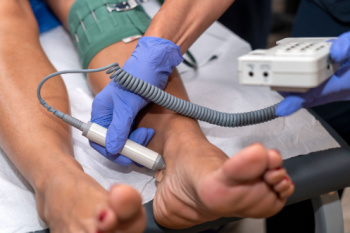February 2024
Education on Diabetic Foot Care

Educating diabetic patients about foot care is vital for preventing serious complications. Diabetes can lead to nerve damage and poor circulation in the feet, increasing the risk of infections and ulcers. Proper foot care practices, such as daily inspection, keeping feet clean and dry, trimming nails carefully, and wearing appropriate footwear, can help diabetic individuals avoid these issues. Additionally, understanding the importance of regular foot examinations by podiatrists can aid in early detection and treatment of any problems. Podiatrists play a vital role in assessing foot health, providing specialized care, and offering valuable guidance on preventive measures. If you have diabetes, it is strongly suggested that you schedule regular appointments with a podiatrist for examinations and important education that may help to prevent serious consequences of diabetes in the feet.
Diabetic foot care is important in preventing foot ailments such as ulcers. If you are suffering from diabetes or have any other concerns about your feet, contact John McGhan, DPM from Gold Canyon Foot & Ankle. Our doctor can provide the care you need to keep you pain-free and on your feet.
Diabetic Foot Care
Diabetes affects millions of people every year. The condition can damage blood vessels in many parts of the body, especially the feet. Because of this, taking care of your feet is essential if you have diabetes, and having a podiatrist help monitor your foot health is highly recommended.
The Importance of Caring for Your Feet
- Routinely inspect your feet for bruises or sores.
- Wear socks that fit your feet comfortably.
- Wear comfortable shoes that provide adequate support.
Patients with diabetes should have their doctor monitor their blood levels, as blood sugar levels play such a huge role in diabetic care. Monitoring these levels on a regular basis is highly advised.
It is always best to inform your healthcare professional of any concerns you may have regarding your feet, especially for diabetic patients. Early treatment and routine foot examinations are keys to maintaining proper health, especially because severe complications can arise if proper treatment is not applied.
If you have any questions please feel free to contact our office located in Gold Canyon, AZ . We offer the newest diagnostic and treatment technologies for all your foot and ankle needs.
How Tarsal Tunnel Syndrome Is Treated
 Tarsal tunnel syndrome, a condition in which the tibial nerve is compressed as it passes through the tarsal tunnel in the ankle, has a variety of treatment options. Conservative treatment is usually recommended at first. This may include rest and nonsteroidal anti-inflammatory drugs, or NSAIDs to reduce inflammation and alleviate pain. Shoe choice is also important. Wearing supportive footwear and using orthotic inserts can help alleviate pressure on the affected nerve. In cases where conservative measures do not resolve symptoms, corticosteroid injections may be administered to reduce inflammation and provide relief. Severe or persistent cases may require surgical intervention to release the compressed nerve. Each treatment approach is tailored to the patient's specific symptoms and needs. If you have pain and numbness along the inner side of the ankle or bottom of your foot and suspect you have developed tarsal tunnel syndrome, it is suggested you consult a podiatrist who can diagnose you and offer personalized treatment.
Tarsal tunnel syndrome, a condition in which the tibial nerve is compressed as it passes through the tarsal tunnel in the ankle, has a variety of treatment options. Conservative treatment is usually recommended at first. This may include rest and nonsteroidal anti-inflammatory drugs, or NSAIDs to reduce inflammation and alleviate pain. Shoe choice is also important. Wearing supportive footwear and using orthotic inserts can help alleviate pressure on the affected nerve. In cases where conservative measures do not resolve symptoms, corticosteroid injections may be administered to reduce inflammation and provide relief. Severe or persistent cases may require surgical intervention to release the compressed nerve. Each treatment approach is tailored to the patient's specific symptoms and needs. If you have pain and numbness along the inner side of the ankle or bottom of your foot and suspect you have developed tarsal tunnel syndrome, it is suggested you consult a podiatrist who can diagnose you and offer personalized treatment.
Tarsal tunnel syndrome can be very uncomfortable to live with. If you are experiencing tarsal tunnel syndrome, contact John McGhan, DPM of Gold Canyon Foot & Ankle. Our doctor can provide the care you need to keep you pain-free and on your feet.
Tarsal Tunnel Syndrome
Tarsal tunnel syndrome, which can also be called tibial nerve dysfunction, is an uncommon condition of misfiring peripheral nerves in the foot. The tibial nerve is the peripheral nerve in the leg responsible for sensation and movement of the foot and calf muscles. In tarsal tunnel syndrome, the tibial nerve is damaged, causing problems with movement and feeling in the foot of the affected leg.
Common Cause of Tarsal Tunnel Syndrome
- Involves pressure or an injury, direct pressure on the tibial nerve for an extended period of time, sometimes caused by other body structures close by or near the knee.
- Diseases that damage nerves, including diabetes, may cause tarsal tunnel syndrome.
- At times, tarsal tunnel syndrome can appear without an obvious cause in some cases.
The Effects of Tarsal Tunnel Syndrome
- Different sensations, an afflicted person may experience pain, tingling, burning or other unusual sensations in the foot of the affected leg.
- The foot muscles, toes and ankle become weaker, and curling your toes or flexing your foot can become difficult.
- If condition worsens, infections and ulcers may develop on the foot that is experiencing the syndrome.
A physical exam of the leg can help identify the presence of tarsal tunnel syndrome. Medical tests, such as a nerve biopsy, are also used to diagnose the condition. Patients may receive physical therapy and prescriptive medication. In extreme cases, some may require surgery.
If you have any questions please feel free to contact our office located in Gold Canyon, AZ . We offer the newest diagnostic and treatment technologies for all your foot and ankle needs.
Vascular Foot Health Among the Elderly Population

Peripheral arterial disease, also known as PAD, is a condition that happens when your leg arteries become narrow due to a build-up of fat inside them. It can cause pain and weakness in your legs and feet when you walk, but the pain generally dissipates when you rest. Some older people with PAD do not feel any symptoms because they may have other health problems, or their symptoms are not the usual foot and leg pain. Doctors use simple tests to find out if you have PAD. They measure the blood pressure in your ankles and arms and compare them. If the ankle pressure is lower, it means you might have PAD. This condition is more common as people get older, and it is linked to things that can include smoking, diabetes, high blood pressure, and elevated cholesterol levels. If you have peripheral arterial disease and feel pain in your feet and legs, it is suggested that you schedule an appointment with a podiatrist who can perform a proper diagnosis, and guide you toward treatment that can help to improve blood flow.
Proper foot care is something many older adults forget to consider. If you have any concerns about your feet and ankles, contact John McGhan, DPM from Gold Canyon Foot & Ankle. Our doctor can provide the care you need to keep you pain-free and on your feet.
The Elderly and Their Feet
As we age we start to notice many changes in our body, but the elder population may not notice them right away. Medical conditions may prevent the elderly to take notice of their foot health right away. Poor vision is a lead contributor to not taking action for the elderly.
Common Conditions
- Neuropathy – can reduce feeling in the feet and can hide many life-threatening medical conditions.
- Reduced flexibility – prevents the ability of proper toenail trimming, and foot cleaning. If left untreated, it may lead to further medical issues.
- Foot sores – amongst the older population can be serious before they are discovered. Some of the problematic conditions they may face are:
- Gouging toenails affecting nearby toe
- Shoes that don’t fit properly
- Pressure sores
- Loss of circulation in legs & feet
- Edema & swelling of feet and ankles
Susceptible Infections
Diabetes and poor circulation can cause general loss of sensitivity over the years, turning a simple cut into a serious issue.
If you have any questions please feel free to contact our office located in Gold Canyon, AZ . We offer the newest diagnostic and treatment technologies for all your foot and ankle needs.
Diagnosing a Lisfranc Fracture

Lisfranc fractures, occurring deep within the midfoot, present a diagnostic challenge due to their intricate location amidst a multitude of bones and tendons. Often misdiagnosed, these fractures result from either broken bones or torn ligaments supporting the midfoot structure. A Lisfranc fracture can range from mild muscle tears to complex fractures that involve multiple bones and joints. Lisfranc fractures are commonly mistaken for a simple foot sprain and can lead to prolonged pain and complications if left untreated. Low-energy incidents, like missteps or falls during routine activities, typically cause these fractures. High-energy traumas from elevated falls also can result in this type of injury. An accurate diagnosis of a Lisfranc fracture is challenging and requires a thorough evaluation by a podiatrist, using advanced imaging techniques. Proper treatment of Lisfranc fractures, ranging from conservative measures to surgical intervention, is essential for optimal recovery, as ignoring the injury or attempting to walk it off can worsen damage and prolong healing time. If you are experiencing severe pain in the midfoot area, it is suggested that you schedule an appointment with a podiatrist as quickly as possible for a complete exam and diagnosis.
A broken foot requires immediate medical attention and treatment. If you need your feet checked, contact John McGhan, DPM from Gold Canyon Foot & Ankle. Our doctor can provide the care you need to keep you pain-free and on your feet.
Broken Foot Causes, Symptoms, and Treatment
A broken foot is caused by one of the bones in the foot typically breaking when bended, crushed, or stretched beyond its natural capabilities. Usually the location of the fracture indicates how the break occurred, whether it was through an object, fall, or any other type of injury.
Common Symptoms of Broken Feet:
- Bruising
- Pain
- Redness
- Swelling
- Blue in color
- Numbness
- Cold
- Misshapen
- Cuts
- Deformities
Those that suspect they have a broken foot shoot seek urgent medical attention where a medical professional could diagnose the severity.
Treatment for broken bones varies depending on the cause, severity and location. Some will require the use of splints, casts or crutches while others could even involve surgery to repair the broken bones. Personal care includes the use of ice and keeping the foot stabilized and elevated.
If you have any questions please feel free to contact our office located in Gold Canyon, AZ . We offer the newest diagnostic and treatment technologies for all your foot and ankle needs.
